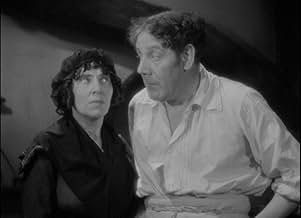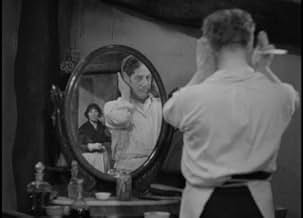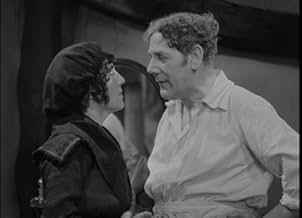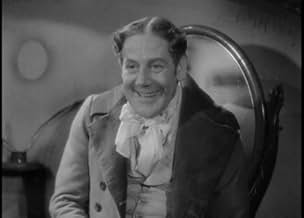Sweeney Todd: The Demon Barber of Fleet Street
- 1936
- 1h 16min
PUNTUACIÓN EN IMDb
5,8/10
1,6 mil
TU PUNTUACIÓN
Añade un argumento en tu idiomaA Fleet Street barber recounts the story of Sweeney Todd, a notorious barber who in the last century murdered many customers for their money.A Fleet Street barber recounts the story of Sweeney Todd, a notorious barber who in the last century murdered many customers for their money.A Fleet Street barber recounts the story of Sweeney Todd, a notorious barber who in the last century murdered many customers for their money.
- Dirección
- Guión
- Reparto principal
John Singer
- Tobias
- (as Johnny Singer)
Graham Soutten
- Beadle
- (as Ben Souten)
Henry B. Longhurst
- Quayside Man Talking to Sweeney
- (sin acreditar)
Ben Williams
- Captain Stephenson
- (sin acreditar)
Reseñas destacadas
Karloff aSt the Monster, Lee and Lugosi as the Count, Lon Chaney jr as the Wolfman, Cushing as the Baron and Tod as Fleet Street's most notorious barber! Certain horror stars are destined to be associated with certain roles and Mr slaughter would forever be identified with Sweeney Todd. Provincial theatregoers and the outlying suburbs of London could be guaranteed a welter of blood - or beetroot juice - whenever Tod came to town for a 2-week residency. By the 30's, he was established as a star turn, having British B films built around him - his old-school melodramas being mostly rewritten from their stage versions to prominently feature him - see Jeffrey Richards excellent article on Slaughter in the book THE UNKNOWN 30'S.
Despite the distancing device of a prologue and epilogue in a modern barbers, the film holds up extremely well. The sailor's battle with the natives at Trader Patterson's shows the grasp of the film's budget exceeding its reach. But all the staples of Victorian melodrama are present - the villain, the hero and heroine, the older man (usually a disapproving Father of the heroine) and a comic couple. Modern day audiences may feel decidedly queasy about the film's maltreatment of Tobias Wragg. Threatened and intimidated by Todd, cheerfully guzzling down god-knows-what in Mrs Lovatt's pies and forced to wear the heroine's clothes - he must have grown into an adult certifiable for treatment. The ending is contrived with Johanna rushing - unconvincingly disguised as a boy - to Sweeney's barbershop and being left to perish in the flames as the villain covers his tracks. Even more unlikely is the way Sweeney stays to watch his emporium go up in flames instead of fleeing with his riches, then rushing in for an ill-advised fight with Jack Ingestre (who adopts a convincing Yorkshire accent for his farmer disguise). The tipping chair was adopted to prevent us actually seeing any throat slitting but it results in a suitably ironic finale as the unconscious Todd is despatched to the inferno below. There is now an official Tod Slaughter website so log on and lend your support to the greatest villain British acting ever produced.
Despite the distancing device of a prologue and epilogue in a modern barbers, the film holds up extremely well. The sailor's battle with the natives at Trader Patterson's shows the grasp of the film's budget exceeding its reach. But all the staples of Victorian melodrama are present - the villain, the hero and heroine, the older man (usually a disapproving Father of the heroine) and a comic couple. Modern day audiences may feel decidedly queasy about the film's maltreatment of Tobias Wragg. Threatened and intimidated by Todd, cheerfully guzzling down god-knows-what in Mrs Lovatt's pies and forced to wear the heroine's clothes - he must have grown into an adult certifiable for treatment. The ending is contrived with Johanna rushing - unconvincingly disguised as a boy - to Sweeney's barbershop and being left to perish in the flames as the villain covers his tracks. Even more unlikely is the way Sweeney stays to watch his emporium go up in flames instead of fleeing with his riches, then rushing in for an ill-advised fight with Jack Ingestre (who adopts a convincing Yorkshire accent for his farmer disguise). The tipping chair was adopted to prevent us actually seeing any throat slitting but it results in a suitably ironic finale as the unconscious Todd is despatched to the inferno below. There is now an official Tod Slaughter website so log on and lend your support to the greatest villain British acting ever produced.
When UK Channel 4 first showed this in the '80's I couldn't initially figure out what they were playing at with such a cheap creaker. But I quickly got sucked into its murky realms, more importantly got into the spirit of the thing and enjoyed it immensely. It's not essential but hissing, booing, stamping your feet and cheering in the right places would help too. Over the years they showed lots of Tod Slaughter's other barnstorming efforts for the Quota-Quickie (George) King, but none turned out as satisfying overall as this is. I'm glad to see it's out there on DVD just in case they never show it again.
Sweeney Todd is an avaricious lecherous conniving violent barber who thinks he is a "tender-hearted chicken" and who has two sidelines: polishing off his customers well and helping the next door shop's production of meat pies. First sensationalised in a play in Victorian times it was supposed to be based on fact; nowadays they're content just to rip you off and not to pieces. Hairy Bruce Seton was the goodie in love with the capitalist's lovely daughter whom Sweeny Todd also actively coveted. Slaughter's performance is a masterclass of Victorian melodrama, no one else ever intentionally equalled him on film if you let him he can replace any derision with admiration for such a marvellously over the top melodramatic performance and his razor-like wit. Same as with the cannibalism the moustache twirling was only implied. His was a style of acting that had died away with the Edwardians but was deliberately continued by him over the following decades, much to the delight of the many theatre audiences who saw him and who interacted with him accordingly. The sweetly melancholic and insistent background music reminds you that you are watching a nostalgic portrayal of a dead world, which would have provided an indescribable frisson to the older members of the original audience watching it at the cinema who perhaps might have first seen the play 50 years before. Slaughter managed to play Todd on stage over 4000 times, but died at age 71 in 1956 just after performing Maria Marten or the Murder In The Red Barn at the Derby Hippodrome now under threat of demolition. I won't ever be watching the new musical because the words "gruesome gory graphic violence" cropped up in reviews why waste my short time left on Earth being debased?
So: an ultra cheaply but lovingly made nostalgic tongue in cheek melodrama a unique priceless treasure indeed.
Sweeney Todd is an avaricious lecherous conniving violent barber who thinks he is a "tender-hearted chicken" and who has two sidelines: polishing off his customers well and helping the next door shop's production of meat pies. First sensationalised in a play in Victorian times it was supposed to be based on fact; nowadays they're content just to rip you off and not to pieces. Hairy Bruce Seton was the goodie in love with the capitalist's lovely daughter whom Sweeny Todd also actively coveted. Slaughter's performance is a masterclass of Victorian melodrama, no one else ever intentionally equalled him on film if you let him he can replace any derision with admiration for such a marvellously over the top melodramatic performance and his razor-like wit. Same as with the cannibalism the moustache twirling was only implied. His was a style of acting that had died away with the Edwardians but was deliberately continued by him over the following decades, much to the delight of the many theatre audiences who saw him and who interacted with him accordingly. The sweetly melancholic and insistent background music reminds you that you are watching a nostalgic portrayal of a dead world, which would have provided an indescribable frisson to the older members of the original audience watching it at the cinema who perhaps might have first seen the play 50 years before. Slaughter managed to play Todd on stage over 4000 times, but died at age 71 in 1956 just after performing Maria Marten or the Murder In The Red Barn at the Derby Hippodrome now under threat of demolition. I won't ever be watching the new musical because the words "gruesome gory graphic violence" cropped up in reviews why waste my short time left on Earth being debased?
So: an ultra cheaply but lovingly made nostalgic tongue in cheek melodrama a unique priceless treasure indeed.
A real curio here, with a totally old-fashioned production and the wonderfully Dickensian Tod Slaughter performance merging well with the intrinsically macabre tale. The subject matter, whether shown or suggested, is sinister, and played as gallows humour by Slaughter. The rest of the cast is hardly particularly impressive, but fits well enough into the story, allowing Slaughter centre-stage most of the time, although there is a bizarre foreign interlude that is somewhat out-of-place.
I love the recurring wistful, whistleable tune - absurdly Romantic, yet very low calorie British too - over the opening credits; very melodic and all the more striking as, besides this refrain, there is little or no other incidental music. The photography, could, I suppose, have been more conducive to 'atmosphere', but what is that but an expectation we have about noirish cinema? This is pure theatrical melodrama. The production is indeed spare and minimal, and we're left largely to enjoy the ripping old story and a fine 'turn' from the star. There are very good lines, presumably tailored to Slaughter's stage performances in the role; he delivers them with Dickensian gusto, in a gloriously theatrical performance, which is the main, if not quite the only reason to view this oddball, watchable antique piece.
I love the recurring wistful, whistleable tune - absurdly Romantic, yet very low calorie British too - over the opening credits; very melodic and all the more striking as, besides this refrain, there is little or no other incidental music. The photography, could, I suppose, have been more conducive to 'atmosphere', but what is that but an expectation we have about noirish cinema? This is pure theatrical melodrama. The production is indeed spare and minimal, and we're left largely to enjoy the ripping old story and a fine 'turn' from the star. There are very good lines, presumably tailored to Slaughter's stage performances in the role; he delivers them with Dickensian gusto, in a gloriously theatrical performance, which is the main, if not quite the only reason to view this oddball, watchable antique piece.
I just saw this film for the first time after searching for it for quite a while. I have long been a fan of the Sweeney Todd story, and this was far from disappointing. The cast is full of the delightful "woe is me" school of actors. Slaughter fits the bill from top to bottom as the grinning cackling Todd. A fine and campy performance. He takes the whole show with little competition. He is a delight to watch playing with his razors and skulking along in his patented style. The sets are atmospheric and effective given the budget, and despite the comic addition of the prologue and epilogue, this is a fine and enjoyable little film. Naturally I also highly recommend the musical, as well as versions of the play for good light reading. This origional 1936 is the definitive. Enjoy!
Sweeny Todd, for being as bizarre and crazy as it is, is very, very well made for the time, and for what I can only guess to be a somewhat limited budget. For that alone, George King deserves some sort of high recognition. The film is captivating and flies by as the viewer watches the tale of Sweeny, the homicidal barber. The movie has great comedic elements that show that the creators are not afraid to laugh at their own production a little bit. The aptly named Tod Slaughter does an amazing role as Sweeny Todd and has a creepy laugh that calls back to many an old silver screen sociopath. For a film that I got in a two-movie pack for fifty cents, I think I've certainly gotten a gem. Now, I best not take this gem to the local barber
¿Sabías que...?
- CuriosidadesOne of over 200 titles in the list of independent feature films made available for television presentation by Advance Television Pictures announced in "Motion Picture Herald" 4/4/1942 . At this time, television broadcasting was in its infancy, almost totally curtailed by the advent of World War II, and would not continue to develop until 1945-1946. Because of poor documentation (feature films were often not identified by title in conventional sources) no record has yet been found of its initial television broadcast. Its earliest documented telecast occurred Saturday 25 November 1944 on New York City's pioneer television station WNBT (Channel 1).
- PifiasThe "stone" steps in Sweeney Todd's cellar make very hollow, wooden-sounding noises when walked upon.
- Citas
Sweeney Todd: May I polish you off sir?
- ConexionesFeatured in Doom Asylum (1988)
Selecciones populares
Inicia sesión para calificar y añadir a tu lista para recibir recomendaciones personalizadas
- How long is The Demon Barber of Fleet Street?Con tecnología de Alexa
Detalles
- Fecha de lanzamiento
- País de origen
- Idioma
- Títulos en diferentes países
- Demon Killer of the Slums
- Localizaciones del rodaje
- Fleet Street, Holborn, Londres, Inglaterra, Reino Unido(opening and closing scenes)
- Empresa productora
- Ver más compañías en los créditos en IMDbPro
- Duración1 hora 16 minutos
- Color
- Relación de aspecto
- 1.37 : 1
Contribuir a esta página
Sugerir un cambio o añadir el contenido que falta

Principal laguna de datos
By what name was Sweeney Todd: The Demon Barber of Fleet Street (1936) officially released in India in English?
Responde























